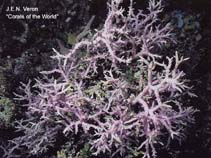Seriatopora dendritica Veron, 2000
Classification / Names Common names | Synonyms | CoL | ITIS | WoRMS
Anthozoa | Scleractinia | Pocilloporidae
Environment: milieu / climate zone / depth range / distribution range Ecology
Sessile; depth range 0 - 40 m (Ref. 847). Tropical; 22°N - 12°S, 95°E - 154°E (Ref. 847)
Distribution Countries | FAO areas | Ecosystems | Occurrences | Introductions
Western Central Pacific: Indonesia to Papua New Guinea.
Length at first maturity / Size / Weight / Age
Maturity: Lm ? range ? - ? cm
Short description Morphology
With thin and tapered branches that appear needle-like. Branches are widely spaced, less than 10 mm long and usually fuse in an irregular manner. Colonies are very delicate and may fall apart when disturbed. Usually pink or cream in color.
Found in protected reef environments (Ref. 847).
Life cycle and mating behavior Maturity | Reproduction | Spawning | Eggs | Fecundity | Larvae
Members of the class Anthozoa are either gonochoric or hermaphroditic. Mature gametes are shed into the coelenteron and spawned through the mouth. Life cycle: The zygote develops into a planktonic planula larva. Metamorphosis begins with early morphogenesis of tentacles, septa and pharynx before larval settlement on the aboral end.
Main reference
References | Coordinator | Collaborators
Allen, G.R. and S.A. McKenna. 2001. (Ref. 75725)
IUCN Red List Status (Ref. 130435)
Vulnerable (VU) (A4c); Date assessed: 01 January 2008
CITES status (Ref. 108899)
Appendix II: International trade monitored
CMS (Ref. 116361)
Not Evaluated
Threat to humans
Human uses
| FishSource |
Tools
More information
Internet sources
BHL | BOLD Systems | CISTI | DiscoverLife | FAO(Publication : search) | Fishipedia | GenBank (genome, nucleotide) | GloBI | Gomexsi | Google Books | Google Scholar | Google | PubMed | Hexacorallians of the World | Tree of Life | Wikipedia (Go, Search) | Zoological Record
Estimates based on models
Preferred temperature
(Ref. 115969): 28.2 - 29.2, mean 28.8 (based on 362 cells).
Price category
(Ref. 80766):
Unknown.



